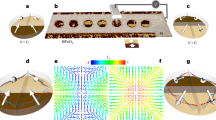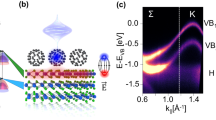Abstract
A major challenge in developing topological superconductors for implementing topological quantum computing is their characterization and control. It has been proposed that a p-wave-gapped topological superconductor can be fabricated with single-atom precision by assembling chains of magnetic atoms on s-wave superconductors with spin–orbit coupling. Here we analyse Bogoliubov quasiparticle interference in Mn chains, constructed atom by atom on Nb(110), and reveal the formation of multi-orbital Shiba bands using momentum-resolved measurements. We find evidence that one band features a topologically non-trivial p-wave gap, as inferred from its shape and particle–hole asymmetric intensity. Our work is an important step towards a distinct experimental determination of topological phases in multi-orbital systems by bulk electron band structure properties only.
This is a preview of subscription content, access via your institution
Access options
Access Nature and 54 other Nature Portfolio journals
Get Nature+, our best-value online-access subscription
$29.99 / 30 days
cancel any time
Subscribe to this journal
Receive 12 print issues and online access
$209.00 per year
only $17.42 per issue
Buy this article
- Purchase on Springer Link
- Instant access to full article PDF
Prices may be subject to local taxes which are calculated during checkout




Similar content being viewed by others
Data availability
Data that support the findings of this paper are available from the corresponding author upon reasonable request. Source data are provided with this paper.
Code availability
The analysis codes that support the findings of the study are available from the corresponding author upon reasonable request.
References
Kitaev, A. Y. Unpaired Majorana fermions in quantum wires. Phys. Usp. 44, 131–136 (2001).
Mourik, V. et al. Signatures of Majorana fermions in hybrid superconductor–semiconductor nanowire devices. Science 336, 1003–1007 (2012).
Zhang, H. et al. Quantized Majorana conductance. Nature 556, 74–79 (2018).
Das, A. et al. Zero-bias peaks and splitting in an Al–InAs nanowire topological superconductor as a signature of Majorana fermions. Nat. Phys. 8, 887–895 (2012).
Albrecht, S. M. et al. Exponential protection of zero modes in Majorana islands. Nature 531, 206–209 (2016).
Deng, M. T. et al. Anomalous zero-bias conductance peak in a Nb–InSb nanowire-Nb hybrid device. Nano Lett. 12, 6414–6419 (2012).
Alicea, J. New directions in the pursuit of Majorana fermions in solid state systems. Rep. Prog. Phys. 75, 076501 (2012).
Beenakker, C. W. J. Search for Majorana fermions in superconductors. Annu. Rev. Condens. Matter Phys. 4, 113–136 (2013).
Elliott, S. R. & Franz, M. Colloquium: Majorana fermions in nuclear, particle and solid-state physics. Rev. Mod. Phys. 87, 137 (2015).
Pientka, F., Glazman, L. I. & von Oppen, F. Topological superconducting phase in helical Shiba chains. Phys. Rev. B 88, 155420 (2013).
Li, J. et al. Topological superconductivity induced by ferromagnetic metal chains. Phys. Rev. B 90, 235433 (2014).
Nadj-Perge, S., Drozdov, I. K., Bernevig, B. A. & Yazdani, A. Proposal for realizing Majorana fermions in chains of magnetic atoms on a superconductor. Phys. Rev. B 88, 020407(R) (2013).
Schecter, M., Flensberg, K., Christensen, M. H., Andersen, B. M. & Paaske, J. Self-organized topological superconductivity in a Yu–Shiba–Rusinov chain. Phys. Rev. B 93, 140503(R) (2016).
Klinovaja, J., Stano, P., Yazdani, A. & Loss, D. Topological superconductivity and Majorana fermions in RKKY systems. Phys. Rev. Lett. 111, 186805 (2013).
Choy, T.-P., Edge, J. M., Akhmerov, A. R. & Beenakker, C. W. J. Majorana fermions emerging from magnetic nanoparticles on a superconductor without spin–orbit coupling. Phys. Rev. B 84, 195442 (2011).
Martin, I. & Morpurgo, A. F. Majorana fermions in superconducting helical magnets. Phys. Rev. B 85, 144505 (2012).
Nadj-Perge, S. et al. Observation of Majorana fermions in ferromagnetic atomic chains on a superconductor. Science 346, 602–607 (2014).
Feldman, B. E. et al. High-resolution studies of the Majorana atomic chain platform. Nat. Phys. 13, 286–291 (2017).
Pawlak, R. et al. Probing atomic structure and Majorana wavefunctions in mono-atomic Fe chains on superconducting Pb surface. npj Quantum Inf. 2, 16035 (2016).
Ruby, M. et al. End states and subgap structure in proximity-coupled chains of magnetic adatoms. Phys. Rev. Lett. 115, 197204 (2015).
Jeon, S. et al. Distinguishing a Majorana zero mode using spin-resolved measurements. Science 358, 772–776 (2017).
Ruby, M., Heinrich, B. W., Peng, Y., von Oppen, F. & Franke, K. J. Exploring a proximity-coupled Co chain on Pb(110) as a possible Majorana platform. Nano Lett. 17, 4473–4477 (2017).
Kim, H. et al. Toward tailoring Majorana bound states in artificially constructed magnetic atom chains on elemental superconductors. Sci. Adv. 4, eaar5251 (2018).
Schneider, L. et al. Controlling in-gap end states by linking nonmagnetic atoms and artificially-constructed spin chains on superconductors. Nat. Commun. 11, 4707 (2020).
Yazdani, A., Jones, B. A., Lutz, C. P., Crommie, M. F. & Eigler, D. M. Probing the local effects of magnetic impurities on superconductivity. Science 275, 1767–1770 (1997).
Heinrich, B. W., Pascual, J. I. & Franke, K. J. Single magnetic adsorbates on s-wave superconductors. Prog. Surf. Sci. 93, 1–19 (2018).
Cornils, L. et al. Spin-resolved spectroscopy of the Yu–Shiba–Rusinov states of individual atoms. Phys. Rev. Lett. 119, 197002 (2017).
Balatsky, A. V., Vekhter, I. & Zhu, J.-X. Impurity-induced states in conventional and unconventional superconductors. Rev. Mod. Phys. 78, 373–433 (2006).
Franke, K. J., Schulze, G. & Pascual, J. I. Competition of superconducting phenomena and Kondo screening at the nanoscale. Science 332, 940–944 (2011).
Choi, D.-J. et al. Mapping the orbital structure of impurity bound states in a superconductor. Nat. Commun. 8, 15175 (2017).
Ruby, M., Peng, Y., von Oppen, F., Heinrich, B. W. & Franke, K. J. Orbital picture of Yu–Shiba–Rusinov multiplets. Phys. Rev. Lett. 117, 186801 (2016).
Crommie, M. F., Lutz, C. P. & Eigler, M. Imaging standing waves in a two-dimensional electron gas. Nature 363, 524–527 (1993).
Hasegawa, Y. & Avouris, P. Direct observation of standing wave formation at surface steps using scanning tunneling spectroscopy. Phys. Rev. Lett. 71, 1071–1074 (1993).
Hofmann, P. H. et al. Anisotropic two-dimensional Friedel oscillations. Phys. Rev. Lett. 79, 265–268 (1997).
Wittneven, C., Dombrowski, R., Morgenstern, M. & Wiesendanger, R. Scattering states of ionized dopants probed by low temperature scanning tunneling spectroscopy. Phys. Rev. Lett. 81, 5616 (1998).
Hoffman, J. E. et al. Imaging quasiparticle interference in Bi2Sr2CaCu2O8+δ. Science 297, 1148–1151 (2002).
Derro, D. J. et al. Nanoscale one-dimensional scattering resonances in the CuO chains of YBa2Cu3O6 + δ. Phys. Rev. Lett. 88, 097002 (2002).
Hoffman, J. E. Spectroscopic scanning tunneling microscopy insights into Fe-based superconductors. Rep. Prog. Phys. 74, 124513 (2011).
Schmidt, A. R. et al. Imaging the Fano lattice to ‘hidden order’ transition in URu2Si2. Nature 465, 570–576 (2010).
Sessi, P. et al. Signatures of Dirac fermion-mediated magnetic order. Nat. Commun. 5, 5349 (2014).
Odobesko, A. B. et al. Preparation and electronic properties of clean superconducting Nb(110) surfaces. Phys. Rev. B 99, 115437 (2019).
Finnemore, D. K., Stromberg, T. F. & Swenson, C. A. Superconducting properties of high-purity niobium. Phys. Rev. 149, 231–243 (1966).
Wiebe, J. et al. A 300-mK ultra-high vacuum scanning tunneling microscope for spin-resolved spectroscopy at high energy resolution. Rev. Sci. Instrum. 75, 4871–4879 (2004).
Beck, P. et al. Spin–orbit coupling induced splitting of Yu–Shiba–Rusinov states in antiferromagnetic dimers. Nat. Commun. 12, 2040 (2021).
Pillet, J. D. et al. Andreev bound states in supercurrent-carrying carbon nanotubes revealed. Nat. Phys. 6, 965–969 (2010).
Schneider, L., Beck, P., Wiebe, J. & Wiesendanger, R. Atomic-scale spin-polarization maps using functionalized superconducting probes. Sci. Adv. 7, eabd7302 (2021).
Nilius, N., Wallis, T. H. & Ho, W. Development of one-dimensional band structure in artificial gold chains. Science 297, 1853–1856 (2002).
Bychkov, Y. A. & Rashba, E. I. Oscillatory effects and the magnetic susceptibility of carriers in inversion layers. J. Phys. C 17, 6039–6045 (1984).
Shanavas, K. V., Popović, Z. S. & Satpathy, S. Theoretical model for Rashba spin–orbit interaction in d electrons. Phys. Rev. B 90, 165108 (2014).
Peng, Y., Pientka, F., Glazman, L. I. & von Oppen, F. Strong localization of Majorana end states in chains of magnetic adatoms. Phys. Rev. Lett. 114, 106801 (2015).
Klinovaja, J. & Loss, D. Composite Majorana fermion wave functions in nanowires. Phys. Rev. B 86, 085408 (2012).
Baum, Y., Posske, T., Fulga, I. C., Trauzettel, B. & Stern, A. Coexisting edge states and gapless bulk in topological states of matter. Phys. Rev. Lett. 114, 136801 (2015).
Kjaergaard, M., Wölms, K. & Flensberg, K. Majorana fermions in superconducting nanowires without spin–orbit coupling. Phys. Rev. B 85, 020503(R) (2012).
von Oppen, F., Peng, Y. & Pientka, F. in Topological Aspects of Condensed Matter Physics: Lecture Notes of the Les Houghes Summer School (eds Chamon, C. et al.) Ch. 9 (Oxford Univ. Press, 2017).
Acknowledgements
L.S., P.B., T.P., J.W. and R.W. gratefully acknowledge funding by the Cluster of Excellence ‘Advanced Imaging of Matter’ (EXC 2056—project ID 390715994) of the Deutsche Forschungsgemeinschaft (DFG). L.S., P.B., J.W. and R.W. acknowledge support by the SFB 925–B9 ‘Light induced dynamics and control of correlated quantum systems’ of the Deutsche Forschungsgemeinschaft (DFG). T.P. acknowledges support by the DFG (project no. 420120155). R.W. acknowledges funding by the European Union via ERC Advanced Grant ADMIRE (project no. 786020). S.R. acknowledges support from the Australian Research Council (DP200101118). We thank D. K. Morr, H. Jeschke and L. Rózsa for helpful discussions. T.P. thanks F. Pientka for clarifying remarks.
Author information
Authors and Affiliations
Contributions
L.S., P.B., R.W. and J.W. conceived the experiments. L.S. and P.B. performed the measurements and analysed the experimental data together with J.W. T.P. derived the effective low-energy Shiba model. L.S. performed the numerical simulations using the effective low-energy Shiba model and the fitting to the experimental data. D.C., E.M. and S.R. performed numerical simulations, which were essential for the understanding of the system. L.S. prepared the figures. L.S. and J.W. wrote the manuscript. All authors contributed to the discussions and to correcting the manuscript.
Corresponding author
Ethics declarations
Competing interests
The authors declare no competing interests.
Additional information
Peer review information Nature Physics thanks Yukio Hasegawa and Jose Pascual for their contribution to the peer review of this work.
Publisher’s note Springer Nature remains neutral with regard to jurisdictional claims in published maps and institutional affiliations.
Supplementary information
Supplementary Information
Supplementary Figs. 1–7, details of the experimental procedures, the QPI analysis and the theoretical model.
Source data
Source Data Fig. 1
Source data Fig 1.
Source Data Fig. 2
Source data Fig 2.
Source Data Fig. 3
Source data Fig 3.
Source Data Fig. 4
Source data Fig 4.
Rights and permissions
About this article
Cite this article
Schneider, L., Beck, P., Posske, T. et al. Topological Shiba bands in artificial spin chains on superconductors. Nat. Phys. 17, 943–948 (2021). https://doi.org/10.1038/s41567-021-01234-y
Received:
Accepted:
Published:
Issue Date:
DOI: https://doi.org/10.1038/s41567-021-01234-y
This article is cited by
-
Electrostatic potentials of atomic nanostructures at metal surfaces quantified by scanning quantum dot microscopy
Nature Communications (2024)
-
Proximity superconductivity in atom-by-atom crafted quantum dots
Nature (2023)
-
Two-dimensional Shiba lattices as a possible platform for crystalline topological superconductivity
Nature Physics (2023)
-
Antiferromagnetism-driven two-dimensional topological nodal-point superconductivity
Nature Communications (2023)
-
Search for large topological gaps in atomic spin chains on proximitized superconducting heavy-metal layers
Communications Physics (2023)



